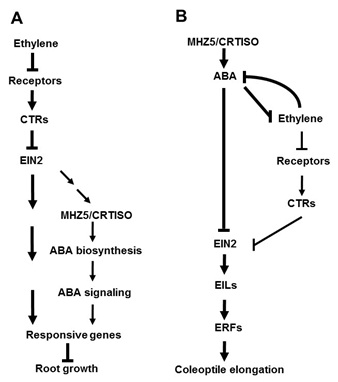Ethylene signaling transduction and carotenoid biosynthesis regulation are less known in rice.
Recently, Prof. ZHANG Jin-Song’group and Prof. CHEN Shou-Yi’group, both from the Institute of Genetics and Developmental Biology, Chinese Academy of Sciences, reported novel interplay among ethylene, carotenogenesis and Abscisic Acid (ABA) in rice.
The rice ethylene-response mutant mhz5, which displays a reduced ethylene response in roots but an enhanced ethylene response in coleoptiles. They found that MHZ5 encodes a carotenoid isomerase, and that the mutation in mhz5 blocks carotenoid biosynthesis, reduces ABA accumulation and promotes ethylene production in etiolated seedlings. ABA can largely rescue the ethylene response of the mhz5 mutant. Ethylene induces MHZ5 expression, the production of neoxanthin, an ABA biosynthesis precursor, and ABA accumulation in roots. MHZ5 overexpression results in enhanced ethylene sensitivity in roots and reduced ethylene sensitivity in coleoptiles.
Their study reveals novel interactions among ethylene,
carotenogenesis andABA and provides insight into improvements in agronomic traits and adaptive growth through the manipulation of these pathways in rice.
Dr. YIN Cui-Cui and Dr. MA Biao are the co-first authors of this paper. This work has been published online on April 3, 2015, in The Plant Cell (doi: 10.1105/tpc.15.00080).
The study was supported by the National Natural Science Foundation of China, 973 Project, CAS Project, and the State Key Lab of Plant Genomics.

Figure . A Proposed Model of the Interactions between Ethylene and the ABA Pathway in Rice Seedlings. (Image by IGDB)
 Figure . A Proposed Model of the Interactions between Ethylene and the ABA Pathway in Rice Seedlings. (Image by IGDB)
Figure . A Proposed Model of the Interactions between Ethylene and the ABA Pathway in Rice Seedlings. (Image by IGDB) CAS
CAS
 中文
中文




.png)
